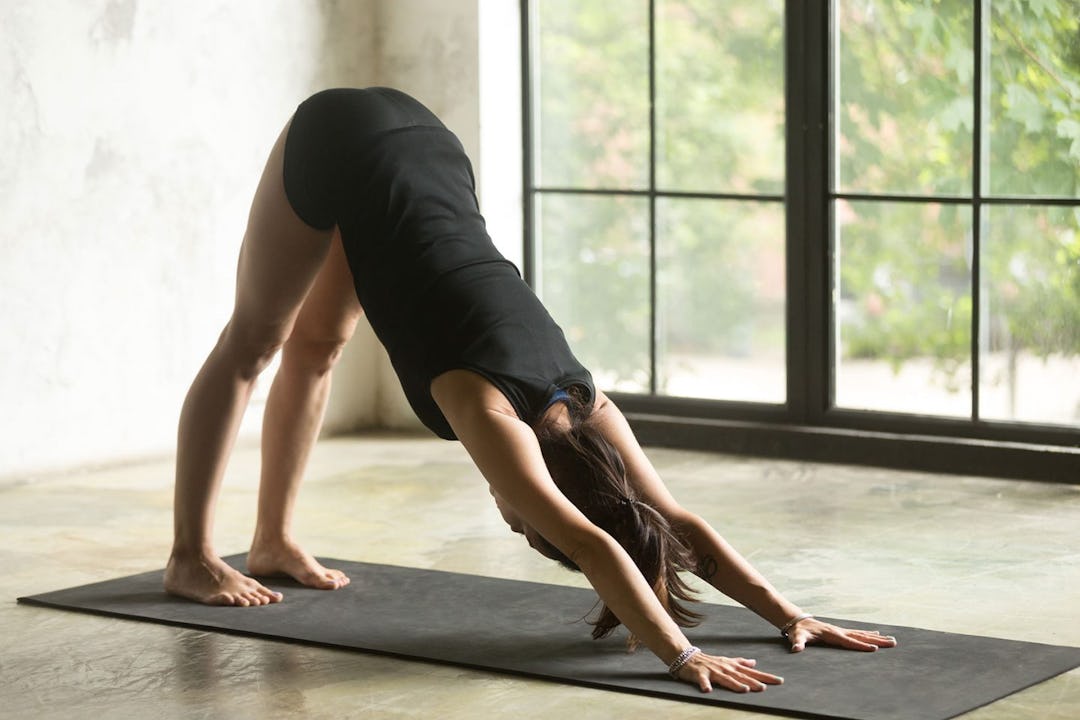For many years I scoffed at yoga – “I’m not a ’yoga person’” I’d say, “If I’m going to spend time working out, I’m going to get a real workout in – one that leaves me drenched in sweat and sore for days.”
I didn’t come to yoga naturally – I wasn’t drawn to flowing pose sequences, mindfulness or even the very real benefit of improved flexibility.
And I stuck to my guns¦until my body rebelled.
Severe, Lower Back Pain Led Me to Yoga
I had my first knock-you-to-your-knees-in-tears back spasm in 2007. I don’t think I’ve even been in such excruciating pain. I couldn’t sit up, stand up or walk without gasping and almost falling over from shooting pains.
Of course it was a Friday. I didn’t have a primary care physician and didn’t want to spend the money to go to a hospital or urgent care facility, so I stayed home from work, popped Tylenol and did the only thing I knew might help – stretch and foam roll.
It took a week to recover from the acute spasm, and I spent the next several years dealing with regular, chronic pain. Sometimes it was better, sometimes it was worse, but I didn’t have another severe spasm until 2013, then again in 2015.
I followed self-care regimens. Saw a chiropractor, took OTC medicine when necessary, used muscle salves and tried just about every foam roller and massage ball on the market. I kept exercising, worked on core strength, paid attention to my diet and tried to tack on a few stretches to the end of my workouts. But the truth was, I was in constant pain.
A New Commitment
It was after my spasm in 2015 that I said, “This isn’t working. I need to try something new.” My sister swore her yoga class helped her lower back pain, so I made a commitment: I’d do a 20-minute yoga class every day for 30 days and see how I felt.

Yoga is for everyone because it’s functional. It improves movement patterns, corrects muscle imbalances and alignment. It requires you to move through a full range of motion as you enhance dynamic flexibility.
It was nothing fancy – just a $15 yoga DVD I’d had sent to me some months previously, but for 30 days, I stuck to the plan. I’d walk my dogs in the morning, then start the DVD.
It became my savior. I noticed I wasn’t hurting as much or as often. I’d spend hours without thinking about lower back pain at all. I could pick things up off the ground without worrying whether my back might give out. I started running again – something I’d given up for some time.
And I began to recognize my own negative movement patterns and correct them by going through simple yoga sequences.
After several months of daily yoga, I stopped following the same routine, but continued incorporating my own sequences into workouts, adding 15 or 20 minutes after a HIIT or strength training session.
Unlike traditional, static stretching, flowing yoga sequences seemed to target more muscle groups simultaneously, working to improve posture and core strength while enhancing flexibility through the hips, glutes, hamstrings and low back – all of my lower back pain trouble zones.
It’s been more than a year since my last spasm, and while I can’t claim the pain is completely gone, I haven’t felt this good in years. I credit yoga for giving me back my¦ well, back.
Yoga’s Benefits Are For Everyone

My experience taught me that yoga is for everyone, and that my own negative views of the practice, “It’s too easy, it won’t benefit me enough, I want a ’real’ workout” were ignorant, self-defeating and short-sighted.
Yoga’s not just for women, or just for people who like to meditate. It’s not just for the super bendy or for people who don’t like to work up a sweat. Though, if you love sweating, try out a hot yoga class.
Yoga is for everyone because it’s functional. It improves movement patterns, corrects muscle imbalances and alignment. It requires you to move through a full range of motion as you enhance dynamic flexibility. It encourages deep breathing which helps circulate oxygen and nutrients to your cells.
And yes, there’s a mindfulness component, but it doesn’t have to be in a “hippie dippie” sort of way. It can teach you to move thoughtfully, to connect your brain and your body so you develop better coordination and balance.
As if these benefits weren’t enough, science also indicates yoga:
· Decreases anxiety and offers promising results as a complementary treatment for depression
· Reduces pain and improves function in patients with arthritis
· Plays a complementary role in treating asthma to improve respiration
· Improves most risk factors associated with cardiovascular disease and diabetes
· Enhances sleep quality, even in patients with insomnia
The Four-Pose Challenge
There are real, legitimate benefits to signing up for an in-person yoga class – namely, you have a trained instructor who walks you through each pose, offering corrections and teaching you how to breathe.
But I’ll be honest, I didn’t jump into in-person classes (at first) because I was worried I’d feel out of place. DVDs and streaming video services, like Black Swan Yoga TV, are great places to find quality instructors and a variety of class styles, lengths and focuses.
But if even that seems a bit out of your comfort zone, I’d encourage you to add these four very simple poses to your next routine.
I’m not going to claim they’re the “best” yoga poses, or the “most effective,” because those descriptors are different for every person and need, but they’re the four poses I turn to most frequently when I need lower back pain relief and a quick mental reset.
Relieve Your Lower Back Pain With These 4 Yoga Poses
Yoga Squat for Lower Back Pain
With your legs slightly wider than hip-distance apart, your weight in your heels, bring your hands to your chest in a prayer position. Press your hips back and bend your knees as you squat down as far as you can, until your glutes are just a few inches from the ground.
Press your elbows to the inside of your knees to keep them aligned with your toes. As you breathe slowly, sink your tailbone toward the floor and lift your chest to lengthen your spine.
Hold the squat for 15 to 20 seconds, stand, then repeat three or four times.
Cat-Cow for Lower Back Pain
On all fours – palms beneath shoulders, knees beneath hips – with your back flat, take a deep breath and look up, drawing your chest forward, hollowing out your low back and pressing your tailbone upward.
On your exhale, reverse the movement, lowering your head between your arms as you tuck your tailbone under and stretch your back up toward the ceiling like a cat.
Continue alternating between Cow and Cat Pose on each inhale and exhale for three to five cycles.
Downward Dog with Foot Pedal for Lower Back Pain
You can transition into Downward Dog from Cat-Cow. After taking a breath in and moving into Cow Pose (head and chest up, low back hollowed, tailbone reaching high), tuck your toes under.
On the exhale, press through your toes and lift your knees from the floor, pressing your hips high into the air as you extend your elbows and knees, dropping your head between your arms.
Your body should look like an inverted “V.” Press through your palms and the balls of your feet as you try to reach your heels toward the floor (they don’t have to touch). Allow your head to hang loose.
From this position, begin pedaling your knees, bending one knee as you straighten the other for a deeper calf stretch, then alternating legs. Continue pedaling your legs for three to five breaths.
Child’s Pose for Lower Back Pain
You can transition into Child’s Pose from Downward Dog by simply lowering your hips until your body reaches high plank position – body straight as you balance on your palms and the balls of your feet. From high plank, place your knees on the ground, spread wide, your feet touching.
Press your hips back until you are sitting on your heels, your arms on the ground in front of you. Reach your palms farther forward to lengthen your spine and feel a stretch through your shoulders as you allow your hips to become heavy, sinking further into your heels.
Breathe deeply and enjoy the pose. Stay here as long as you’d like.

)





